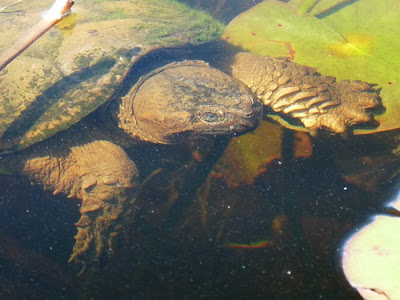
This summer, I re-enlisted in the Lake George Turtle Monitoring Project. (http://www.lakegeorgeassociation.org/lgtmp.htm )
As part of a five-year study, they enlist ordinary folks (that's me) as spotters. There's an orientation (a crash course in turtles of this area), you learn how to record and report what you see, and you are assigned a specific area of Lake George as your territory. Last year, I had Dunham's Bay as my observation area - I had never been there before. From the first day there, I fell in love with the place. I requested it again for this summer. Lake George, 32 miles long, is SO big and open ... I'm happier paddling around in this inlet at the southern extreme of the lake.
It's a wide slow river-marsh that flows from Pickle Hill to the south, zigzagging for miles through a wide swampy valley with hills on both sides. Home to beaver, muskrat, herons and all sort of birds. Oh and TURTLES. Lots of painted turtles, and snapping turtles.
Big ones!

My put-in is at a small dock area. The motorboats all go the other way, north to the open lake. I generally head south, into the marsh.
This week is the last official week of observation for the summer.
Compared to early summer, I see less painted turtles in the marsh, mainly because it's more difficult to get near the edges, where they bask upon the shore.
Nowadays I see them perched on anything that floats: lily roots, muskrat mud-platforms, and lily pads. If I don't immediately ship-oars as soon as I spot one, they dash into the water with a plop. Thanks to my new zoom, I can stay outside their personal space and take some photos. It's tricky since the boat is moving.

Late in the summer, snapping turtles can be hard to find. Perhaps they are spending more time at the bottom, in deep water at least, in these hot days of summer. I've snuck up on some of them at the surface, as they hide under a lily pad or hang out in the profuse plant growth that proliferates along the edges of the channel. It’s tough, because their noses look just like lily buds peeking out of the water (or vice versa.)

During last year’s observations, I came upon a large snapping turtle who was just under the surface, in clear shallow water. I stopped the boat almost directly over him. He had just taken a breath, and settled down, 10 feet under the boat. Checking the time, I sat to watch him, floating above with paddle still. It was a calm and sunny morning. He was looking up at me, and I was admiring him. I figured he'd be back up at the surface for another breath in about 15 minutes.

For more information on turtles, and some fantastic artwork, read The Year of the Turtle: A Natural History by David M. Carroll.
Musk Turtle, a.k.a. Stinkpot - usually secretive, though this one was spotted at high noon:










What fun to go turtling with you -- both paddling beside you and virtually, through your wonderful photos. I'll bet the turtles are attracted to you because they sense you are their patron saint.
ReplyDeleteThanks for the great pics of the wood turtle (and the rest...)!
ReplyDeletecatharus - I was lucky enough to see TWO wood turtles this spring, and what's cool about them is the patterns underneath are so unique to each turtle, they are almost like fingerprints. By checking against a photo from last year, its seems I have seen one particular individual, two years in a row now!
ReplyDeleteWow! It will be interesting to see if you run into either of these same guys again!
ReplyDelete